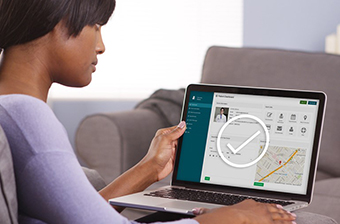Software Security Testing
A Full Guide with Time and Costs
With 22 years in cybersecurity and Certified Ethical Hackers in the team, ScienceSoft offers a full range of security testing services to uncover both common and hidden vulnerabilities, logic flaws, and chained exploits. With our services, software vendors and enterprises get a true picture of their cyber resilience and stay one step ahead of hackers.
Security Testing: Essence
Software security testing is focused on identifying and assessing vulnerabilities that can compromise software protection. A type of non-functional testing, it does not verify if software fulfills its intended functions but examines whether it is securely designed, developed, and configured to withstand potential security threats.
Types: vulnerability assessment, penetration testing, secure code review, compliance assessment, and security audit.
Major cost factors: the number and complexity of the testing targets, the testing types and techniques, the composition of the security testing team.
Security Testing Types
Vulnerability assessment
Extensive identification, analysis, and prioritization of software security flaws.
Penetration testing
Simulation of life-like cyberattacks to detect and explore the existing vulnerabilities and their impact on the company.
Secure code review
Detection of security flaws in application source code, such as encryption errors, buffer overflow, XSS, and SQL injection vulnerabilities.
Compliance assessment
Checking if software security controls meet the requirements of regulatory standards: e.g., PCI DSS, HIPAA, GLBA, GDPR.
Software security audit
A full-scale assessment of software security controls. Checking software protection and evaluating the information security policies and employee cyber resilience.
Common Myths about Software Security Testing
We don't need security testing: our app doesn't operate with sensitive data, so it can't interest cybercriminals.
While sensitive data is a common target, cybercriminals can hack applications for other reasons, for example:
- To deliver malware to other devices or systems that interact with the app.
- To steal login credentials, which can then be used for unauthorized access to other accounts.
- To overload CPU, memory, or other system resources, aiming to disrupt the app's performance or even the entire IT network.
- To execute phishing attacks or scams, tricking app users into revealing personal information or performing actions that benefit the attacker.
Our software has successfully passed compliance checks, so it is well-protected.
Regulatory standards may not envisage measures for new and emerging threats. Also, attackers can exploit vulnerabilities that compliance checks might not cover. Meeting compliance requirements is just a baseline; additional security measures are often needed to fully protect software.
Our developers follow best practices, so our software is secure.
Following best practices reduces the likelihood of software vulnerabilities but doesn't eliminate them entirely. Here are a few reasons why:
- Best practices that are effective today might be insufficient to counter attackers' evolving tactics.
- Developers might be unable to predict all the creative ways attackers can use, especially considering the wide range of scenarios and user interactions.
- If your software relies on third-party libraries, frameworks, and plugins, vulnerabilities in these external components can also pose security risks.
Security testing slows development down; we can check our app after deployment.
Security testing is an integral part of development, not an impediment. Integrating security measures from the beginning helps address security vulnerabilities early, reduce technical debt and related costs, ensure compliance, and maintain user trust.
The Scope of Software Security Testing
It is essential to assess both software security and organizational security controls that comprise robust cyber protection. Therefore, security testing targets may include:
Security Testing Techniques: Ethical Hacking to Enhance Software Cyber Resilience
ScienceSoft's testers simulate real-world hacking tactics to explore how potential attackers can compromise software. Some of the most common techniques include:
Reverse engineering testing
Analyzing software code, binaries, or executables to understand software functionality, vulnerabilities, and potential hidden features.
Testing for remote code execution
Checking if malicious code can be executed on a remote system to install malware, steal data, escalate privileges, or perform other unauthorized activities.
Brute-force testing
Trying combinations of usernames and passwords to see if a potential attacker can guess the correct credentials.
Testing for man-in-the-middle attacks
Attempting to interfere with the communication between software and a web server to evaluate if the data can be intercepted and altered.
Clickjacking testing
Checking if a hacker can conceal malicious content behind seemingly legitimate UI elements and trick users into performing actions for the attacker's benefit.
SQL injection testing
Manipulating web app input fields or parameters to see if it is possible to craft SQL queries to misuse the database content.
Cross-site scripting (XSS) testing
Checking if malicious scripts can be injected into a web application, which can then be executed by users, potentially leading to data theft or unauthorized actions.
Cross-site request forgery (CSRF) testing
Manipulating an application to see if it is possible to make it perform unauthorized actions on behalf of an authenticated user.
Server-side request forgery (SSRF) testing
Checking if it is possible to make a server send requests to internal or external resources and elicit data or compromise security in another way.
Software Security Testing Setup Plan
The unique security considerations of various applications demand a case-by-case approach to security test planning and execution. Below, we outline the typical flow of projects at ScienceSoft.
1.
Planning
- Assigning a manager to plan and oversee the security testing project.
- Defining the scope of the cybersecurity checkup: the targets, testing types, and time frame.
- Estimating the budget of the project.
- Designing the data handling policy: collecting, storing, sharing, and deleting test data.
- Planning a mitigation strategy for possible risks related to the software security checkup: e.g., unintentional data exposure or software crashing.
- Optimizing the plan to ensure against redundant efforts and expenses.
A company should plan at least one penetration test per year and one vulnerability assessment per quarter. Ideally, a security test should follow any major change in software or IT infrastructure.
2.
Preparation
- Gathering a team of cybersecurity professionals with relevant skills and experience in similar projects.
- Deciding on the security testing approach and techniques: for example black box, gray box, or white box tests, destructive (SQL injections, DDoS attacks, application level floods, brute-force attacks, etc.) or non-destructive (social engineering, vulnerability scanning, etc.) techniques.
- Selecting appropriate open-source or/and commercial tools, depending on the assessment goals:
- To identify and classify known software vulnerabilities: general software scanners, container vulnerability scanners, Security Content Automation Protocol (SCAP) scanners, etc.
- To see how software weaknesses can be exploited: password-cracking tools, fuzzers, web crawlers, dynamic application security testing (DAST) tools, exploitation frameworks, etc.
- To detect code issues: static and dynamic code analysis tools, and more.
- To evaluate adherence to applicable compliance standards: sensitive data finders, automated evidence collection tools, compliance scanners, and others.
- Deciding if a test environment is needed. This can be a reasonable solution if the team applies intrusive techniques that may damage the production environment.
- Obtaining the required access to the target assets and data for test execution.
3.
Launch and execution
The launch and execution phase will differ depending on the testing scope and, consequently, the type:
- Vulnerability assessment. Duration: 1–2 weeks.
- Running automated scans on the target software to identify existing vulnerabilities.
- Manual review of scanning results to eliminate false positives.
- Analyzing detected vulnerabilities and their causes, evaluating their severity.
- Reporting on the results with recommendations on how to fix the vulnerabilities.
- Penetration testing. Duration: 1–3 weeks.
- Vulnerability scanning: identifying exploitable vulnerabilities.
- Vulnerability exploitation: simulation of true-to-life attacks.
- Analyzing the exploited vulnerabilities and their impact on compromised software.
- Reporting and remediation guidance.
- Secure code review. Duration: 1–8 weeks.
- Automated scanning of the application source code.
- Manual review.
- Analyzing detected vulnerabilities.
- Reporting on the findings and recommendations on enhancing the protection of the application.
- Compliance assessment. Duration: up to 10 weeks.
- Running vulnerability scanners, reviewing application source code, and using pentesting techniques to find software security flaws.
- Defining deviations from regulatory standards and advising on their mitigation.
- Report on Compliance and/or Attestation of Compliance.
- Security audit. Duration: up to 14 weeks.
- Analyzing security policies and procedures.
- Interviewing employees to assess their cybersecurity awareness.
- Incorporating vulnerability assessment, penetration testing, code review, and compliance assessment, depending on the audit scope.
- A report with detailed description and analysis of all findings as well as recommendations on how to fix the revealed weaknesses.
When choosing a provider to take over the software security testing process in your company, you may be guided by:
- Credentials and testimonials. Certifications (ISO 9001, ISO 27001, CEH, etc.) and real people reviews serve as tangible quality proof.
- Portfolio.
- The qualifications and experience of the team: preferably dedicated specialists skilled in automated and manual techniques.
- Reports that should include a sound analysis of identified vulnerabilities and their causes, as well as remediation guidance for each finding.
Consider Professional Security Testing Services
Security testing consulting
- Analyzing your software.
- Advising on the security testing type, approach, and techniques.
- Cost calculation.
- Developing the testing strategy and plan.
-
Help with the interpretation of the test finding.
Security testing outsourcing
- An optimal strategy for your security testing needs and scope.
- Vulnerability assessment, pentesting, compliance assessment, or security audit, depending on your goals and needs.
- Description and prioritization of the existing vulnerabilities.
- Remediation recommendations.
Why Choose ScienceSoft
- Since 2003 in cybersecurity.
- A solid portfolio of successfully completed projects.
- A competent team: Certified Ethical Hackers, compliance consultants, certified cloud security experts, certified ISO 27001 internal auditors, and more.
- ISO 9001-certified mature quality management to guarantee smooth cooperation and value-driving results.
- The safety of our clients' data ensured by ISO 27001-certified security management system.
Typical Roles on ScienceSoft's Security Testing Team
The composition of the team is tailored to specific scope and requirements. Here is a list of ScienceSoft’s experts who may be involved in different projects.
Security testing manager
- Plans a security testing project depending on the negotiated scope.
- Manages security testing process and the team.
- Supervises security testing execution.
- Communicates with the customer to coordinate the project.
Vulnerability analyst
- Runs vulnerability scans on applications, networks, and devices to identify vulnerabilities.
- Performs a manual review of the findings to exclude false positives.
- Evaluates the severity of discovered vulnerabilities.
- Analyzes the root causes of the vulnerabilities.
- Reports on the findings and advises on remediation steps.
Penetration test engineer
- Locates and explores exploitable vulnerabilities.
- Identifies entry points and methods hackers can use.
- Develops penetration scripts and tests.
- Simulates hackers’ attacks on applications, networks, or devices.
- Evaluates the impact of the detected weaknesses on the company.
- Provides recommendations on security risk mitigation.
Security code review analyst
- Performs a manual analysis of application source code.
- Selects or develops automation tools for code review.
- Identifies vulnerabilities in the code.
- Recommends remediation actions.
IT compliance specialist
- Reviews a company’s IT security policies and procedures, evaluating their compliance with regulatory standards.
- Investigates if all mandatory software security controls are in place and meet regulatory requirements.
- Documents compliance deviations.
- Offers mitigation guidance.
- Collaborates on compliance documentation.
IT security auditor
- Reviews a company’s security policies and procedures.
- Verifies employees’ security awareness.
- Evaluates the effectiveness of software security controls.
- Provides a comprehensive report of the audit and a security risk management plan.
Security Testing Sourcing Models
Management and implementation are in-house
- Minimizing the risk of sensitive data leaks.
- A good understanding of the company’s processes and IT environment.
- Limited skills and experience.
- “Inside-the-box” thinking due to the familiarity of the IT environment, which can be fraught with missing certain vulnerabilities.
- The need to update the security testing toolkit and hold training for the testers.
- Salaries and maintenance costs.
Management and implementation are completely outsourced
- Solid experience and best practices: a wide choice of advanced cybersecurity assessment technologies and skills.
- Cost-effectiveness and reduced TCO.
- The vendor takes over the test plan, preparation, and implementation.
- An independent expert view.
- Exposing your IT assets to a third party may be risky unless you deal with a reliable vendor.
- The team needs time to get familiar with the specifics of your software and IT environment.
Management is in-house; the test team is completely or partially external
- Flexibility: scaling up and down, depending on the testing needs.
- Control: the internal manager who overviews the testing process.
- It may be difficult to find a well-versed expert able to design the security testing strategy and ensure smooth cooperation and monitoring.
Cybersecurity Goals We Help Achieve
Defend against ever-evolving cyber threats
We stay tuned for popular and more sophisticated hacking tricks to help protect your software against both common and advanced cyberattacks.
Why important: 44% was the rise in cyberattacks worldwide in 2024 compared to 2023, according to CheckPoint.
Streamline vulnerability remediation
Our team not only provides a comprehensive view of software vulnerabilities. We prioritize the detected issues, advise on efficient corrective measures, and are ready to fix any flaws in your software.
Why important: One of the most prevalent initial access techniques is exploiting vulnerabilities in public-facing applications or unpatched operating systems, according to Microsoft.
Maintain compliance
Our security engineers collaborate with compliance consultants to identify and rectify gaps related to data protection standards such as HIPAA, PCI DSS, GDPR, and others.
Why important: Under HIPAA, the penalty for violations can reach $1.5M per year. GDPR fines can reach €20M or 4% of annual revenue. PCI DSS non-compliance penalties can reach $100,000 per month, according to ISMS.online.
Common Questions Answered
Can software security testing be fully automated?
Automated tools are great at detecting many security issues quickly, but they cannot fully replace the deep understanding and skills of experts who perform manual testing. Here's why:
- Automated tools depend on established patterns, potentially overlooking new vulnerabilities that are not in the databases.
- These tools often generate false positives: struggling to grasp an application's unique context and logic, they may confuse intended actions with security threats.
- They disregard human creativity, including advanced hacking methods.
What does manual software security testing involve?
During manual vulnerability exploration, our security testers:
- Use threat modeling to identify potential threats and prioritize testing efforts.
- Probe inputs, interactions, and configurations to uncover security flaws.
- Dig into the application's architecture, code, and logic to identify hidden vulnerabilities.
- Analyze the unique context of the application, including business rules, user roles, and specific functionalities.
- Simulate less common or more sophisticated attacks that go beyond the scope of automated tools, and more.
How does software security testing contribute to information assurance practices?
IT security tests serve as a robust information assurance tool that safeguards information assets in line with core security requirements:
- Confidentiality: Data security testing identifies vulnerabilities that could potentially lead to the exposure of sensitive information.
- Integrity: Information security testing examines vulnerabilities that might result in unauthorized tampering or data changes.
- Authentication: Security tests assess authentication mechanisms to ensure that only authorized users can access the system.
- Availability: IT security tests help prevent cyberattacks that may lead to system crashes or data loss.
- Authorization: Security testing verifies the implementation of proper authorization mechanisms, restricting access based on user roles.
- Non-repudiation: Security testing validates audit trails, logs, and transaction records, ensuring that actions can be traced back to responsible parties.
Tools ScienceSoft Uses to Assess Software Protection
Along with vulnerability scanners and automated penetration testing tools, cybersecurity professionals use:
- Static application security testing tools to find vulnerabilities in the app's architecture and source code.
- Dynamic application security test tools to explore the app's security flaws through the front end.
- Software composition analysis tools to analyze open-source application components.
Having hands-on experience with multiple security testing automation tools, ScienceSoft's experts competently choose an optimal toolset for each project to get quick and accurate results.
Vulnerability assessment and penetration testing
Secure code review
Smart contract security review
Security Testing Costs
The costs of a security checkup vary across different projects, depending on the scope of testing required for a particular company.
General cost factors
- The number and complexity of the testing targets.
- The testing types and techniques: vulnerability scanning, black or white box approach, security code review, social engineering, etc.
For in-house security testing
- The size of the security testing team (salaries and benefit packages, additional training).
- Creating and maintaining the working environment for the security testing unit.
- Toolkit maintenance (license fees).
For outsourced security testing
- The number of security testers and their qualifications.
- One-time or long-term cooperation (a vendor may be willing to reduce the costs for subsequent assessments).

Depending on the factors described above, software security testing activities may cost anywhere from $5,000 to $15,000+.
Sample price: Social engineering campaign and gray-box pentesting of customer-facing software (a web and a mobile application) and its external APIs may cost $15,000+.
Would you like to find out your security testing costs?
Wondering How Much Software Security Testing Will Cost You?
Answer a few simple questions about your security assessment needs. This will help our team estimate the cost for your unique case much quicker.
Thank you for your request!
We will analyze your case and get back to you within a business day to share a ballpark estimate.
In the meantime, would you like to learn more about ScienceSoft?
- 21 years in cybersecurity: check what we do.
- 4,000 successful projects: explore our portfolio.
- 1,300+ incredible clients: read what they say.


About ScienceSoft
ScienceSoft is a global provider of cybersecurity services headquartered in McKinney, Texas, US. With Certified Ethical Hackers on board, ScienceSoft’s team offers their expertise to help our clients enhance their cyber defense and maintain their compliance with regulatory standards. Customer information safety is ensured by ISO 27001 certification.














